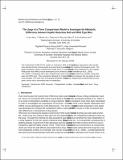The usage of a three-compartment model to investigate the metabolic differences between hepatic reductase null and wild-type mice
Abstract
The Cytochrome P450 (CYP) system is involved in 90% of the human body’s interactions with xenobiotics and due to this, it has become an area of avid research including the creation of transgenic mice. This paper proposes a three-compartment model which is used to explain the drug metabolism in the Hepatic Reductase Null (HRN) mouse developed by the University of Dundee (Henderson, C. J., Otto, D. M. E., Carrie, D., Magnuson, M. A., McLaren, A. W., Rosewell, I. and Wolf, C. R. (2003) Inactivation of the hepatic cytochrome p450 system by conditional deletion of hepatic cytochrome p450 reductase. J. Biol. Chem. 278, 13480–13486). The model is compared with a two-compartment model using experimental data from studies using wild-type and HRN mice. This comparison allowed for metabolic differences between the two types of mice to be isolated. The three sets of drug data (Gefitinib, Midazolam and Thalidomide) showed that the transgenic mouse has a decreased rate of metabolism.
Citation
Hill , L , Chaplain , M A J , Wolf , R & Kapelyukh , Y 2015 , ' The usage of a three-compartment model to investigate the metabolic differences between hepatic reductase null and wild-type mice ' , Mathematical Medicine and Biology , vol. Advance Access . https://doi.org/10.1093/imammb/dqv029
Publication
Mathematical Medicine and Biology
Status
Peer reviewed
ISSN
1477-8602Type
Journal article
Rights
© 2015, the Author(s). Published by Oxford University Press on behalf of the Institute of Mathematics and its Applications. All rights reserved. This work is made available online in accordance with the publisher’s policies. This is the author created, accepted version manuscript following peer review and may differ slightly from the final published version. The final published version of this work is available at http://imammb.oxfordjournals.org/content/early/2015/10/04/imammb.dqv029.full
Description
L.H. is currently funded by the Research Foundation Flanders (FWO) and the Belgian Science Policy Office under Grant No. IAP-VI/10.Items in the St Andrews Research Repository are protected by copyright, with all rights reserved, unless otherwise indicated.

